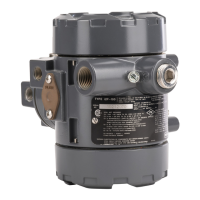Instruction Manual
D103198X012
i2P-100 Transducer
July 2014
14
Note
If the i2P‐100 transducer is used in a valve assembly with a positioner, no hook‐up for diagnostic testing is required for the i2P‐100.
The hook‐up for diagnostic testing should be installed at the positioner.
Install the connectors and hardware between the i2P‐100 transducer and the actuator.
1. Before assembling the pipe nipple, pipe tee, pipe bushings, actuator piping, and connector body, apply sealant to
all threads.
2. Turn the pipe tee to position the connector body and body protector for easy access when doing diagnostic testing.
Vent
When using natural gas as the supply medium ensure that the following warnings are read and understood. Contact
your Emerson Process Management sales office if you have any questions regarding the information contained in this
section.
WARNING
This unit vents the supply medium into the surrounding atmosphere. When installing this unit in a non‐hazardous
(non‐classified) location in a confined area, with natural gas as the supply medium, you must remotely vent this unit to a
safe location. Failure to do so could result in personal injury or property damage from fire or explosion, and area
re‐classification.
When installing this unit in a hazardous (classified) location remote venting of the unit may be required, depending upon
the area classification, and as specified by the requirements of local, regional, and federal codes, rules and regulations.
Failure to do so when necessary could result in personal injury or property damage from fire or explosion, and area
re‐classification.
Vent line piping should comply with local and regional codes and should be as short as possible with adequate inside
diameter and few bends to reduce case pressure buildup.
If a remote vent is required, the vent line must be as short as possible with a minimum number of bends and elbows.
To connect a remote vent, remove the plastic vent (key 71, figure 13). The vent connection is 1/4 NPT internal. Use
3/8‐inch tubing to provide a remote vent.
Electrical Connections
WARNING
For explosion‐proof applications, or when using natural gas as the supply medium, disconnect power before removing the
housing cap. Personal injury or property damage from fire or explosion may result if power is not disconnected before
removing the cap.
For intrinsically safe installations, refer to the nameplate or to instructions provided by the barrier manufacturer, for
proper wiring and installation.
Note
For North American explosion‐proof applications in the Class/Division system, the i2P‐100 has been designed such that a conduit
seal is not required. For all other applications install the product as per local, regional, or national code, rules, and regulations.

